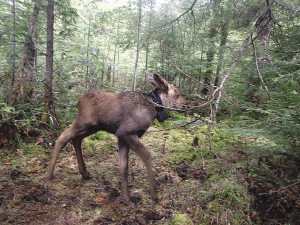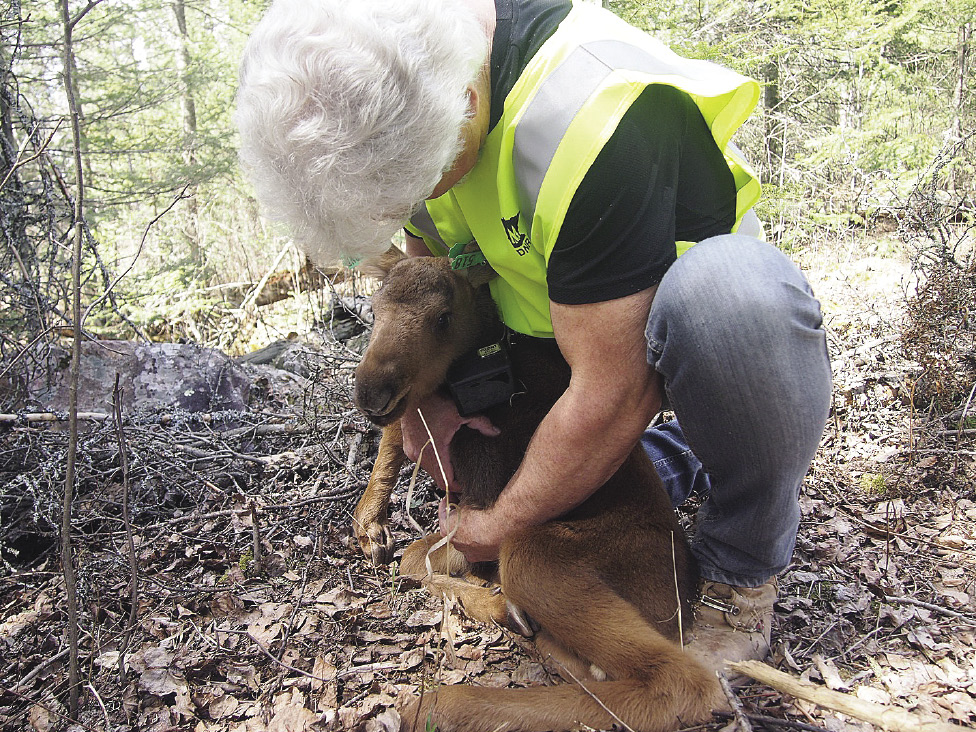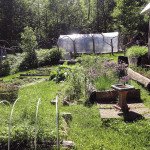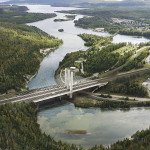Sue Prom once saw 17 moose while driving from the end of the Gunflint Trail to Grand Marais. That was in 1998.
These days, she feels fortunate to see one moose while making that same trip.
“We don’t see that many now, but people have great memories of seeing moose on the Gunflint Trail,” said Prom, co-owner of Voyageur Canoe Outfitters. “And everyone loves our moose, visitors and locals alike.”
In recent years, there has been a tremendous amount of discussion, media coverage and concern about Minnesota’s declining moose population. The latest results from the Minnesota Department of Natural Resources annual moose survey placed the 2015 statewide moose population estimate at 3,450. This compares with an estimate of 4,350 in 2014. Overall, the number of moose is down approximately 60 percent from the 2006 estimate of 8,840. However staggering these statistics may be, they are merely estimates, stressed Alan Ek, head of the Department of Forest Resources at the University of Minnesota.
“Moose surveys are very complicated and subject to a number of assumptions,” Ek said. “This is in large part because moose are quite mobile. This means the precision and accuracy of moose surveys is very difficult to assess.”
Also, Ek noted, the moose surveys apparently do not include areas beyond the primary moose zone, including areas where moose are known to exist, though not necessarily in large numbers.
Regardless of the accuracy of recent moose surveys, it is impossible to deny that the overall population is shrinking in numbers. As wildlife researchers seek credible answers to the question of why Minnesota’s moose population continues to dwindle, a feeling of uncertainty has many people in the Northern Wilds coverage area crying foul at recent research conducted on moose in the region. In addition to studying adult moose, Minnesota wildlife researchershave spent the past two years collaring and trying to study newborn calves. There are many reasons for the study, though its primary purpose is to “determine causes of death in Minnesota’s moose to enhance the understanding of what factors may be responsible for the population’s recent decline,” according to the DNR. In order to complete the analysis, researchers are attaching collars with GPS tracking devices to the necks of newborn moose for the first time ever. Many of these moose are dying. The question is, how big of an influence are the researchers themselves playing in the mortality rate of infant moose in Minnesota?

“I appreciate the effort behind trying to find out what is going on with the moose,” said Sarah Hamilton, owner of Trail Center Lodge on the Gunflint Trail, “but killing the majority of calves they are collaring is sickening.”
Despite many uncertainties revolving around the study, what is known is that the first two years of the effort have been viewed as unsuccessful from a public perspective and from that of the media, according to GlennDelGiudice, the moose project leader for the DNR’s Forest Wildlife and Populations Research Unit. At the same time, what is being overlooked is that researchers are working diligently to fix the problems and that continuing the study is essential to the future of the moose in Minnesota, he added.
“People are saying ‘why not leave (the moose) alone? You’re killing some, just leave them alone. Let nature takes its course,’” DelGiudice said. “If we do that, we won’t learn more about survival rates each year, when they do die, what is killing them naturally and how that’s quantitatively impacting population dynamics year to year.”
To claim that the calf study hasn’t received a great deal of public support is likely an understatement. As of March 10, more than 1,350 people have signed an online petition supporting an end to the study, according to figures at change.org. Among the harshest critics who signed the petition was Erika Butler, a former wildlife veterinarian for the DNR.
“The benefits of this study do not outweigh the harm being done,” Butler said. “There does not need to be a long-term study on neonatal-moose mortality.”
Butler, who was laid off from the DNR in September of 2013, said researchers were overwhelmed with the amount of calf abandonments that occurred as a result of the study. Consequently, many of the calves that were abandoned were left to starve to death, Butler stated. When she voiced her concern over the abandonment issues, Butler said she received little response from DNR officials.
“No one did anything about it, despite the concerns of their own agency wildlife vet,” Butler said.
When given the opportunity to respond to the petition in general and specifically to Butler’s comments, DelGiudice replied: “No thanks.”
“Engaging this sort of thing lends credibility to it,” he continued. “We’re professionals and I won’t do that.”
Whatever opinions the public holds, one fact remains: Thus far, there have been few calves to study. And this has nothing to do with an inability to collar newborn moose. On the contrary, as the calves often remain still and show little fear when approached by wildlife researchers, DelGiudice said. The trouble starts soon after the collars are placed on the calves. The phenomenon known as “capture-related abandonment”—which is essentially when a mother (cow) moose leaves her calf as a result of interference from humans and the calf subsequently dies—has been a major obstacle in the success of the first two years of the study. In May and June of 2014, researchers put GPS collars on 25 moose calves, according to figures provided by DelGiudice. The trouble was, 19 of the 25 calves either were abandoned by their mothers or their collars fell off prematurely, leaving only six calves to be studied. Before the end of the summer, all six of the remaining calves that could be studied had died. All six were killed by predators, including wolves.
The study in 2013 didn’t fare much better. That year 49 calves were collared and 15 either lost their collars or were abandoned by their mothers. A majority of the remaining 2013 calves in the study died before the study year was complete. Once again, wolves and bears accounted for most of the mortality of the 34 collared calves being studied, DelGiudice noted.
However, heading into the 2015 calving season, DelGiudice said researchers are “extremely optimistic” that the study will be successful. Working with the telemetry company that manufactures the GPS collars, the calf-study teams have updated the collars, which in the two previous years have been prone to slip off and occasionally caused abrasions on the animals’ necks. Local researchers worked with the GPS manufacturers, including a company in Germany, and ran tests on cattle to fix those problems for 2015.
The other reason for optimism is that the research team seems to have found a better means of approaching the calves, one that relies on stealth and appears to cause less abandonment from cows. Instead of using a helicopter, as the capture crews did in 2013 and has often been the preferred method of locating collared adult moose with calves in other North American studies, during the first phase of captures in 2014, researchers located and approached calf-birthing sites without the assistance of a helicopter and handled the calves for about five minutes. But even without helicopter assistance, abandonments occurred. During the second phase of last year’s study, researchers limited their capture team to just two people and spent no more than 60 seconds with the calves, or just long enough to identify the animal’s sex and to slip the GPS collar onto the animal’s neck. This approach dramatically lessened the probability of calf abandonment and ultimately increased the likelihood of successfully tracking calves throughout the year as long as they didn’t die from natural causes, DelGiudice explained.
Regardless of the calf survival rate, the study is viewed as groundbreaking from a scientific standpoint, according to DelGiudice. The use of “cutting-edge technology” has the ongoing study following the movements of moose in ways never done before anywhere in the world. The ability to study the locations, movement and habitat use of such young moose on an hourly basis with GPS tracking is an entirely new process, DelGiudice said. In the past, when VHF-radio collars were used, researchers didn’t have the ability to closely monitor the cow-calf relationship, he added.
“If we don’t use this technology we’re not going to get the data we need to answer the primary questions,” he said. “And the primary questions focus on why is this population declining?”
A difficult aspect for the media and general public to grasp concerning this study, DelGiudice said, is how essential it is concerning the future of the Minnesota moose population. Rather than thinking on “individual” terms, where the loss of each moose is viewed as a tragedy, the study paints a larger picture that will provide detailed, quantitative information about moose survival and reproduction at a population scale. Because moose mortality rates and the reason they die tend to fluctuate within a healthy ecosystem, it is vital that the study be conducted over a period of years, not just a two-year sample, DelGiudice said. The study’s “cutting-edge research” will allow for critical data previously undocumented when it comes to moose-calf mortality and the numerous potential factors that influence it, such as habitat, proximity of the mother, her age, condition and investment in her offspring.
“All data from these collared calves are important,” DelGiudice said. “Survival, cause-specific mortality, and home range and habitat use… right up to their time of death or for the full year if they live that long.”
The other aspect of this study that has been challenging for people to understand, DelGiudice said, is that the research teams are doing groundbreaking work when it comes to capture-related mortality and calf abandonment. As it turns out, the very subject people are upset about concerning the study—which is basically that the researchers are harming the calves by collaring them—is actually a secondary purpose of the study itself. No previous research has ever noted the high level of abandonment the Minnesota researchers are seeing, according to DelGiudice. Complicating an already delicate situation, some cows during the study came back after leaving their calves and left repeated times, only to leave for good two to three days after the collaring. At this point, researchers have no idea why some cows leave and some cows stay with their young, according to DelGiudice.
Despite the negative result of a calf dying, at the very least researchers will be able to better understand how capture-related mortality works because they can reach a kill or abandonment so much faster than in previous studies. Which in simplerterms means: ‘If you want to make an omelet, you’ve got to break a few eggs.’
But this omelet does not come cheap. The project operates under a budget of approximately $250,000 annually. The funds come from a collection of grants and directly from the DNR, DelGiudice stated. In addition to the DNR project, similar studies are being conducted by the Natural Resources Research Institute in Duluth and several tribal agencies in Minnesota.
However groundbreaking using GPS collars on calf moose might be, the uncertainty of why Minnesota’s moose population continues to dwindle remains the heart of the issue. Theories abound and range from wolf predation to climate change. ome University of Minnesota scientists, including Ek, believe habitat change, including a lack of timber harvest, could play a role in the decline.
“In the long run, habitat always plays a major role in shaping moose numbers,” Ek said. “In the short run, weather and weather-induced or facilitated conditions can lead to problems with a variety of insect, disease or predator issues. This makes finding the key factor in moose population numbers very difficult, in the short run and especially with small samples.”
What makes pinpointing one specific cause of the dwindling moose population problematic is that oftentimes the reasons vary annually or semi-annually, DelGiudice said. For example, on Isle Royale there is a healthy population of moose living among wolves, and a balance seems to have naturally been reached with predator and prey. Therefore, to assume that wolves are the sole reason for the declining population of moose in Northeast Minnesota is not an educated assumption, according to many well-respected state and national biologists and wildlife researchers.
To complicate matters, in some areas of northeastern Minnesota, moose seem to be thriving, such as the Middle Gunflint and areas recently burned by forest fires. However, to observe that the moose population is faring well in one particular spot and then assume it means something on a larger scale is comparable to the mistake of claiming climate change is a myth because it happens to be cold in a particular location for a few days during winter. In other words, DelGiudice said, in order to solve the ongoing saga of the moose, peoplehave to think on a larger scale and set aside or accept individual losses of moose along the way, including the death of calves.
And for people such as Prom, that is easier said than done.
“I’m not a moose researcher,” she said, “but collaring and killing more calves to figure out what kills a small 14 percent of the calf population doesn’t seem like it makes sense.”
DelGiudice said this year’s effort, which starts when the first calves are born in early May, includes two teams of two people. Those researchers are highly educated, trained and experienced, he added. The goal is to get GPS collars on 50 calves with the intent of studying them for one year or however long they survive.
“This year, after capturing 50 calves, if these collars stay on those not killed by natural causes for a year,” DelGiudice said, “we’ll not only get great seasonal survival and cause-specific mortality rates over the year, but great seasonal home-range determinations and habitat compositions. Such data from all of the collared calves, up to their point of natural death, or for the full year if they survive that long, are incredibly valuable to what we’re trying to figure out.”





